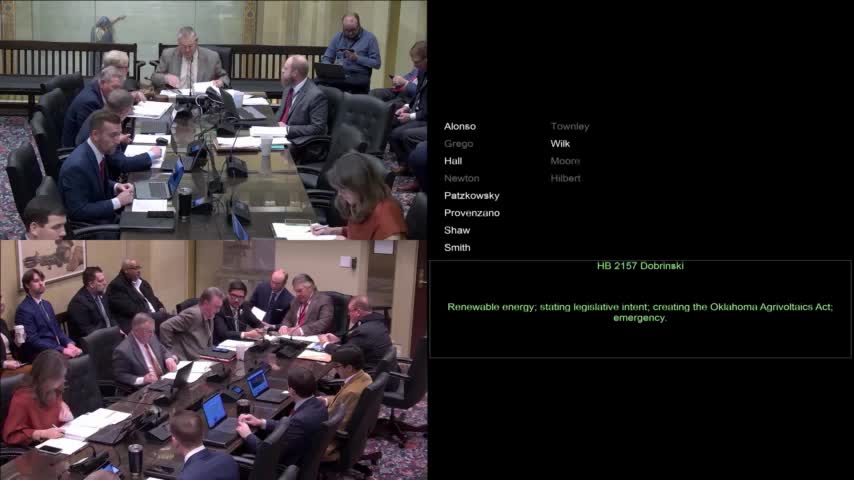Committee advances agrivoltaics bill after lawmakers debate farm benefits and energy reliability
February 10, 2025 | 2025 Legislature OK, Oklahoma
This article was created by AI summarizing key points discussed. AI makes mistakes, so for full details and context, please refer to the video of the full meeting. Please report any errors so we can fix them. Report an error »

A House committee voted 7-2 to report out House Bill 21-57, the Oklahoma Agrivoltaics Act, after members debated whether integrating solar infrastructure with agriculture can preserve farmland and provide benefits to producers.
The bill’s presenter, Representative (presenter), described agrivoltaics as a “dual use opportunity” and said the measure is “a step toward trying to better manage” the pace and placement of renewable generation in the state. He noted the proposal came from a constituent and said it aims “to continue agricultural production along with new energy developments that are coming at us quickly.”
The nut graf: supporters told the committee the bill would create a framework to encourage combined solar-and-farm operations so that land used for energy generation can also continue to produce crops or provide grazing; opponents questioned whether promoting solar development would accelerate reliance on intermittent resources.
Representative Shaw asked whether the bill would “promote the advancement of unreliable energy in our state,” saying “wind and solar have been largely affirmed as being intermittent and and unreliable energy.” Representative (presenter) replied that renewable projects are already being built and that the bill seeks to “manage the pace” and help ensure developers site projects in places that make sense for Oklahoma and for agricultural use.
Representative Alonzo Sandoval, who said he was “a big fan of agrivoltaics,” asked how farmers could benefit. Representative (presenter) and Representative Patzkowski offered examples, including using panels to shade dairy cattle and to allow both power generation and continued agricultural production beneath arrays. Patzkowski told the committee to “imagine a solar panel over a big dairy farm. We power the dairy, have shade for the dairy cattle, farmer likes it, generates electricity, he gets electricity free out of his solar panels.”
After questions, a motion of “do pass” was made, seconded and the committee opened the vote. The clerk recorded a tally of 7 yeas and 2 nays and the committee reported the bill to the next committee with the request that the author obtain a senate author prior to oversight.
The bill’s discussion lasted several minutes and included back-and-forths about where and how dual-use solar installations might work; no specific funding mechanisms, state regulatory changes, or statutory citations were listed in the committee record.
The committee also urged the bill’s author to continue working on details; Representative (presenter) said he was “continuing to work on this, and I’m glad to ask any questions.”
The measure will move on for further consideration; the committee record shows it was reported out with 7 yeas and 2 nays.
The bill’s presenter, Representative (presenter), described agrivoltaics as a “dual use opportunity” and said the measure is “a step toward trying to better manage” the pace and placement of renewable generation in the state. He noted the proposal came from a constituent and said it aims “to continue agricultural production along with new energy developments that are coming at us quickly.”
The nut graf: supporters told the committee the bill would create a framework to encourage combined solar-and-farm operations so that land used for energy generation can also continue to produce crops or provide grazing; opponents questioned whether promoting solar development would accelerate reliance on intermittent resources.
Representative Shaw asked whether the bill would “promote the advancement of unreliable energy in our state,” saying “wind and solar have been largely affirmed as being intermittent and and unreliable energy.” Representative (presenter) replied that renewable projects are already being built and that the bill seeks to “manage the pace” and help ensure developers site projects in places that make sense for Oklahoma and for agricultural use.
Representative Alonzo Sandoval, who said he was “a big fan of agrivoltaics,” asked how farmers could benefit. Representative (presenter) and Representative Patzkowski offered examples, including using panels to shade dairy cattle and to allow both power generation and continued agricultural production beneath arrays. Patzkowski told the committee to “imagine a solar panel over a big dairy farm. We power the dairy, have shade for the dairy cattle, farmer likes it, generates electricity, he gets electricity free out of his solar panels.”
After questions, a motion of “do pass” was made, seconded and the committee opened the vote. The clerk recorded a tally of 7 yeas and 2 nays and the committee reported the bill to the next committee with the request that the author obtain a senate author prior to oversight.
The bill’s discussion lasted several minutes and included back-and-forths about where and how dual-use solar installations might work; no specific funding mechanisms, state regulatory changes, or statutory citations were listed in the committee record.
The committee also urged the bill’s author to continue working on details; Representative (presenter) said he was “continuing to work on this, and I’m glad to ask any questions.”
The measure will move on for further consideration; the committee record shows it was reported out with 7 yeas and 2 nays.
View full meeting
This article is based on a recent meeting—watch the full video and explore the complete transcript for deeper insights into the discussion.
View full meeting
